|
Title: |
Spitfire: Aces of
the Empire |
|
Reviewer: |
Tom Cleaver |
|
Notes: |
Examples from Victory Models'
"Spitfire: Aces of the Empire decal sheet" |
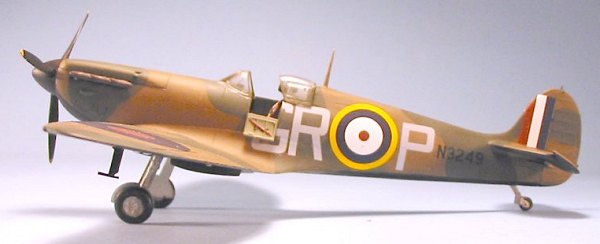 Before going further, I should state that I was one of the "Spitfire boffins" who was contacted last year by Paul Cotcher of Victory Decals, to
work on creating a "definitive" decal sheet for the Spitfire in the various
marks of this famous aircraft that saw combat during the war, and providing
markings for some of the more significant pilots who sat in its cockpit and
flew it into immortality. Some of these men are very widely-known, and at
least some of the specific airplanes they flew have been modeled so many
times they likely belong on Lee Kolosna's list of "Flying Cliches."
However, as I said recently regarding the well-known Corsair flown by Ike Kepford,
even these well-known airplanes have not really been well-served by the
aftermarket, where mistakes made early on by "expert guessers" have been
used as the foundation f
Before going further, I should state that I was one of the "Spitfire boffins" who was contacted last year by Paul Cotcher of Victory Decals, to
work on creating a "definitive" decal sheet for the Spitfire in the various
marks of this famous aircraft that saw combat during the war, and providing
markings for some of the more significant pilots who sat in its cockpit and
flew it into immortality. Some of these men are very widely-known, and at
least some of the specific airplanes they flew have been modeled so many
times they likely belong on Lee Kolosna's list of "Flying Cliches."
However, as I said recently regarding the well-known Corsair flown by Ike Kepford,
even these well-known airplanes have not really been well-served by the
aftermarket, where mistakes made early on by "expert guessers" have been
used as the foundation f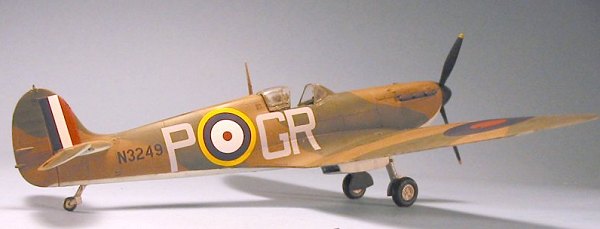 or
what is really a very shaky edifice as regards accuracy. When Paul's
invitation arrived in my e-mail "in-box," I jumped at the chance to get
some markings for Spitfires I had always wanted to see done, and to help
correct some of the more obvious mistakes made over the years by our
predecessors.
or
what is really a very shaky edifice as regards accuracy. When Paul's
invitation arrived in my e-mail "in-box," I jumped at the chance to get
some markings for Spitfires I had always wanted to see done, and to help
correct some of the more obvious mistakes made over the years by our
predecessors.
That said, the group assembled - Bob Swaddling (deservedly known as "Mr.
Spitfire"), Robert Bracken (author of "Spitfire: The Canadians"), Rex
Barker, Scott Ellis, Mal Kingston, Malcolm Laird, Jonathan Strickland, and
myself - was well-rounded and expansive in terms of general and specific
knowledge. Bringing decal artist Jennings Heilig aboard, who kept
asking the right questions to get a decal sheet and who collaborated
closely with Paul in keeping the discussion from running off into various
possible dead ends, the project has created some pretty intere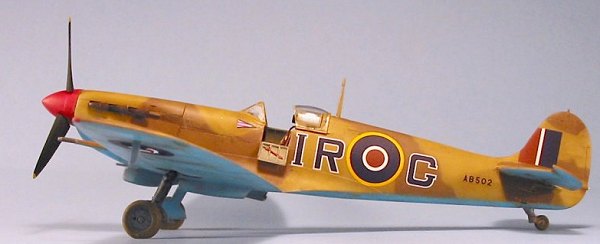 sting
stuff if I do say so myself.
sting
stuff if I do say so myself.
Many of the subjects, particularly the "Malta Blue" Spitfires, are frankly
the result of best-informed historical deduction, ending in a guess. No
one was able to say "this is the way it is" without being challenged; the
investigation was very thorough, until we came to the point where we could
say, "This is as much as anyone will ever figure out." It was amazing to
me, the number of photographs the others had access to, to give a start for
figuring out how a specific airplane might have looked. I myself was able
to bring up the question of the changeover from Dark Earth/Dark Green/Sky
to Ocean Grey/Dark Green/Sea Grey Medium, and point out airplanes that most
likely were among those over-painted at the time with whatever was
available for Ocean Grey (which was in short supply at the time), which
leads to some very interesting-looking paint
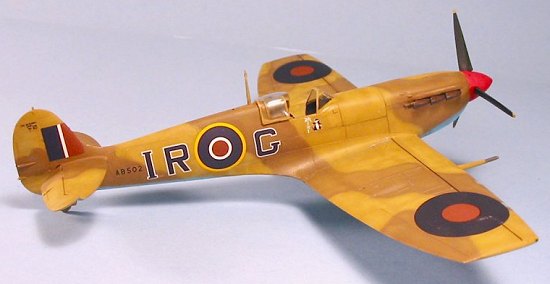 schemes. We have - in the case
of aces Johnny Johnson, Colin Gray, George Buerling, Neville Duke, Clive
Caldwell and Bob Tuck -, been able to present other Spitfires they flew at
various points in their careers, beyond the better-known "flying clichés."
schemes. We have - in the case
of aces Johnny Johnson, Colin Gray, George Buerling, Neville Duke, Clive
Caldwell and Bob Tuck -, been able to present other Spitfires they flew at
various points in their careers, beyond the better-known "flying clichés."
Since the sheet has been released, I've heard some buyers have complained
that the Sky color used in the squadron codes is too dark. I can only say
that we decided to match that to the Tamiya "Sky" color, which we concluded
was the most-accurate representation of that World War II color (post-war
"Sky" is a very different shade). Three of the Spitfires I have done
using the sheet and present here will demonstrate that - on the model - the
code letters look right if you use the right paint colors.
All that said, here are some examples of what is possible with this sheet.
How did I do so many so fast, you ask? Well, when the possibility of doing
some Spitfires in markings I had always wanted to have in the collection, I
built some new 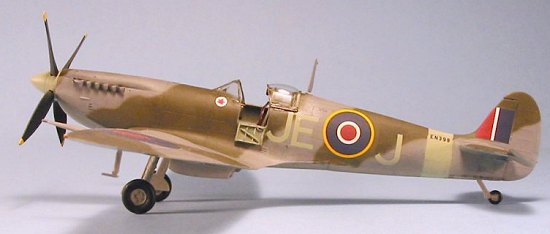 Spitfires and restored a few older models, getting them
painted, etc., to the point where I could use the decals when they arrived.
There was an original hope that the sheet would be out last Fall, which
wasn't possible for a variety of reasons, so when the sheet arrived I had
quite a few models ready to go with the decals.
Spitfires and restored a few older models, getting them
painted, etc., to the point where I could use the decals when they arrived.
There was an original hope that the sheet would be out last Fall, which
wasn't possible for a variety of reasons, so when the sheet arrived I had
quite a few models ready to go with the decals.
For a review of that sheet, please
follow this link
The Models:
1.
Spitfire I, N3249, 92 Squadron, May 24, 1940 - Flight Lt. Robert
Stanford-Tuck:
This is the Spitfire Tuck flew over Dunkirk. N3249 is specifically
mentioned in Tuck's biography "Fly For Your Life" as the airplane he was
flying when he shot down two Bf-110s in one mission and a third later on
May 24, and the following day when he destroyed two Do-17s and became the
first Spitfire ace of the war.
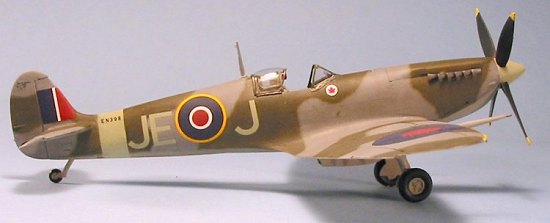 The model is the Tamiya Spitfire I, with kit decals for the stenciling;
the national insignia, serial number and squadron codes all come from the
new sheet.
The model is the Tamiya Spitfire I, with kit decals for the stenciling;
the national insignia, serial number and squadron codes all come from the
new sheet.
2.
Spitfire Vb, AB502; Wing Commander Ian R. Gleed, OC 244 Wing, Tunisia,
1943:
Previously, a modeler could do Gleed's well-known "Figaro" in a
limited-production kit from Hasegawa which is nowadays quite expensive if
you can find it. With this new sheet, a modeler can use any Spitfire V kit
that includes the Aboukir filter. While the Hasegawa decal sheet was quite
accurate, it had Figaro pulling down something one cannot identify -
Jennings got this right, and Figaro is pulling down a white palm tree,
symbol of the Afrika Korps, and thereby self-explanatory.
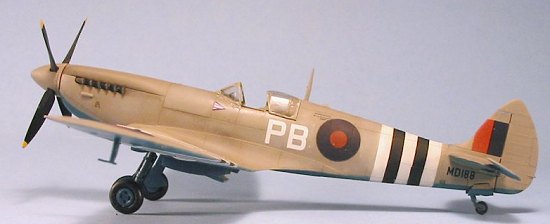 This model is in fact the original Hasegawa Gleed release, restored, since
the overall finish had deteriorated in the nine years it has been in my
collection. Since the real airplane was over-painted in desert camo at
Aboukir, there is no stenciling beyond the wing-walk, and the pattern is an
approximation of the "B" scheme (and that pattern is provided on the
instruction sheet). All decals used on this model come from the new sheet.
This model is in fact the original Hasegawa Gleed release, restored, since
the overall finish had deteriorated in the nine years it has been in my
collection. Since the real airplane was over-painted in desert camo at
Aboukir, there is no stenciling beyond the wing-walk, and the pattern is an
approximation of the "B" scheme (and that pattern is provided on the
instruction sheet). All decals used on this model come from the new sheet.
3.
Spitfire IXB, EN398, Wing Commander Johnny Johnson, Kenly Wing, 1943:
Probably the best-known Spitfire on the sheet will be this one flown by
Johnson when he became commander of the Kenley Wing in May 1943. The
airplane was well-documented in photos, and was likely the easiest of all
the airplanes on the sheet to do.
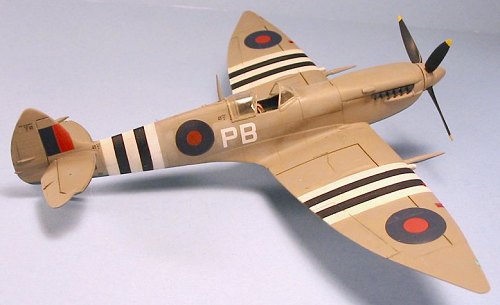 The model is the ICM Spitfire IX with a True Details Cockpit and Falcon
canopy, with stenciling from a SuperScale sheet. All national insignia and
individual markings are from the new sheet.
The model is the ICM Spitfire IX with a True Details Cockpit and Falcon
canopy, with stenciling from a SuperScale sheet. All national insignia and
individual markings are from the new sheet.
4.
Spitfire VII, MD108, Wing Commander Pete Brothers, OC Culmhead Wing, June
1944:
These markings were previously done (incorrectly) on a SuperScale sheet
that had the national insignia in the wrong shades of blue and red, as well
as having Brothers' initials in white, rather than light grey.
The model is the Hasegawa Spitfire VII, with Falcon canopy and rear glass
corrected for the Spitfire VII. Stenciling came from the kit decals, all
the national insignia and individual markings are from the new sheet.
 5.
Spitfire XII, EN625, 91 Squadron, May 1943; Squadron Leader Raymond
Harries:
5.
Spitfire XII, EN625, 91 Squadron, May 1943; Squadron Leader Raymond
Harries:
Ray Harries was the only pilot to become an ace on the Spitfire XII with 9
kills, and was the top-scoring Welsh ace with 16.5 kills total. I have
always wanted to do Spitfire XII in these markings, and the possibility of
finally getting them was a major reason why I joined the rest of the "Boffins"
on this project.
The model is a "restoration" of a conversion of the Tamiya Spitfire Vb,
using the now out-of-production Bringuer Aviation Products resin conversion
set for "C" wing, the Griffon cowling and prop, and the later wide-chord
rudder. EN625 was a Spitfire V conversion, as revealed by the
non-retractable tail wheel.
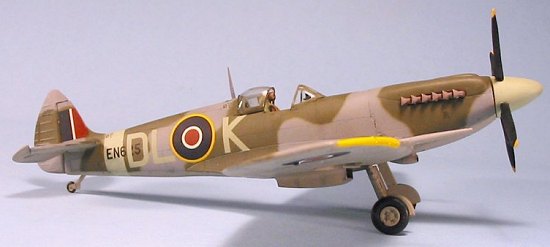 6.
Spitfire XII, MB882, 41 Squadron, 1943; Flight Lt. Donald Smith:
6.
Spitfire XII, MB882, 41 Squadron, 1943; Flight Lt. Donald Smith:
Spitfire XII EB-B is primarily well-known for being the subject of some
very spectacular air-to-air photographs done by Charles Brown, the man who
created modern air-to-air photography. Donald Smith was an ace, though he
only added one kill to his score while flying the Mk. XII. MB882 was one
of the last Mk. XII Spits, and converted from a Mk. VIII airframe, with
retractable tail wheel.
The model is a conversion of a Tamiya Spitfire Vb, using the Red-Roo resin
"C" wing conversion, a wide-chord rudder and retractable tail wheel from
the Hasegawa Mk. IX kit, and a cowling modified from a Hobbycraft Seafire
XV with corrected cylinder cowls.
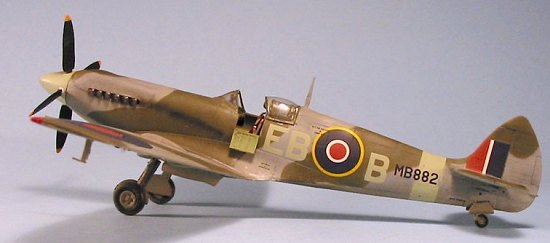 (NOTE: for those who want to do the Spitfire XII, I strongly suggest you
wait for Gavia's Spitfire XII, which should be released later this year.)
(NOTE: for those who want to do the Spitfire XII, I strongly suggest you
wait for Gavia's Spitfire XII, which should be released later this year.)
Conclusions:
The decals are good. They seem thick when you first look at them on the
sheet, but they go down easily under an application of Micro-Sol. The
colors of the national insignia are the right shades of blue and red for
World War II insignia. I think most will agree that the Sky letters look
right on the models.
Let's see, there are two others I am already doing (Bader's Mk.IIa and
Tuck's last Vb). I am sure that over the next year or so there will be a
lot more 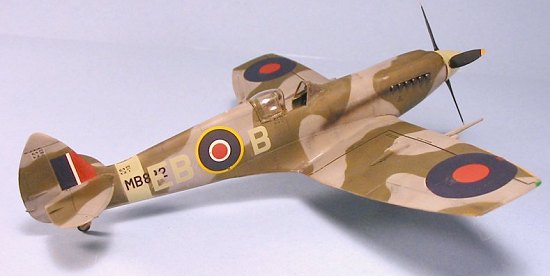 Spitfires in my collection. It's my favorite airplane, and this
sheet provides material for 40 different airplanes. I am sure you'll be
able to find 7 or 8 you just "gotta do."
Spitfires in my collection. It's my favorite airplane, and this
sheet provides material for 40 different airplanes. I am sure you'll be
able to find 7 or 8 you just "gotta do."
Thanks to Paul Cotcher for the chance to be "present at the creation."
Decal sheet courtesy of
Victory
Models.
If you would like your product reviewed fairly and quickly by a
site that has over 200,000 visitors a month, please contact
me or see other details in the Note to
Contributors.
 Before going further, I should state that I was one of the "Spitfire boffins" who was contacted last year by Paul Cotcher of Victory Decals, to
work on creating a "definitive" decal sheet for the Spitfire in the various
marks of this famous aircraft that saw combat during the war, and providing
markings for some of the more significant pilots who sat in its cockpit and
flew it into immortality. Some of these men are very widely-known, and at
least some of the specific airplanes they flew have been modeled so many
times they likely belong on Lee Kolosna's list of "Flying Cliches."
However, as I said recently regarding the well-known Corsair flown by Ike Kepford,
even these well-known airplanes have not really been well-served by the
aftermarket, where mistakes made early on by "expert guessers" have been
used as the foundation f
Before going further, I should state that I was one of the "Spitfire boffins" who was contacted last year by Paul Cotcher of Victory Decals, to
work on creating a "definitive" decal sheet for the Spitfire in the various
marks of this famous aircraft that saw combat during the war, and providing
markings for some of the more significant pilots who sat in its cockpit and
flew it into immortality. Some of these men are very widely-known, and at
least some of the specific airplanes they flew have been modeled so many
times they likely belong on Lee Kolosna's list of "Flying Cliches."
However, as I said recently regarding the well-known Corsair flown by Ike Kepford,
even these well-known airplanes have not really been well-served by the
aftermarket, where mistakes made early on by "expert guessers" have been
used as the foundation f or
what is really a very shaky edifice as regards accuracy. When Paul's
invitation arrived in my e-mail "in-box," I jumped at the chance to get
some markings for Spitfires I had always wanted to see done, and to help
correct some of the more obvious mistakes made over the years by our
predecessors.
or
what is really a very shaky edifice as regards accuracy. When Paul's
invitation arrived in my e-mail "in-box," I jumped at the chance to get
some markings for Spitfires I had always wanted to see done, and to help
correct some of the more obvious mistakes made over the years by our
predecessors. sting
stuff if I do say so myself.
sting
stuff if I do say so myself. schemes. We have - in the case
of aces Johnny Johnson, Colin Gray, George Buerling, Neville Duke, Clive
Caldwell and Bob Tuck -, been able to present other Spitfires they flew at
various points in their careers, beyond the better-known "flying clichés."
schemes. We have - in the case
of aces Johnny Johnson, Colin Gray, George Buerling, Neville Duke, Clive
Caldwell and Bob Tuck -, been able to present other Spitfires they flew at
various points in their careers, beyond the better-known "flying clichés."  Spitfires and restored a few older models, getting them
painted, etc., to the point where I could use the decals when they arrived.
There was an original hope that the sheet would be out last Fall, which
wasn't possible for a variety of reasons, so when the sheet arrived I had
quite a few models ready to go with the decals.
Spitfires and restored a few older models, getting them
painted, etc., to the point where I could use the decals when they arrived.
There was an original hope that the sheet would be out last Fall, which
wasn't possible for a variety of reasons, so when the sheet arrived I had
quite a few models ready to go with the decals. The model is the Tamiya Spitfire I, with kit decals for the stenciling;
the national insignia, serial number and squadron codes all come from the
new sheet.
The model is the Tamiya Spitfire I, with kit decals for the stenciling;
the national insignia, serial number and squadron codes all come from the
new sheet. This model is in fact the original Hasegawa Gleed release, restored, since
the overall finish had deteriorated in the nine years it has been in my
collection. Since the real airplane was over-painted in desert camo at
Aboukir, there is no stenciling beyond the wing-walk, and the pattern is an
approximation of the "B" scheme (and that pattern is provided on the
instruction sheet). All decals used on this model come from the new sheet.
This model is in fact the original Hasegawa Gleed release, restored, since
the overall finish had deteriorated in the nine years it has been in my
collection. Since the real airplane was over-painted in desert camo at
Aboukir, there is no stenciling beyond the wing-walk, and the pattern is an
approximation of the "B" scheme (and that pattern is provided on the
instruction sheet). All decals used on this model come from the new sheet. The model is the ICM Spitfire IX with a True Details Cockpit and Falcon
canopy, with stenciling from a SuperScale sheet. All national insignia and
individual markings are from the new sheet.
The model is the ICM Spitfire IX with a True Details Cockpit and Falcon
canopy, with stenciling from a SuperScale sheet. All national insignia and
individual markings are from the new sheet. 5.
Spitfire XII, EN625, 91 Squadron, May 1943; Squadron Leader Raymond
Harries:
5.
Spitfire XII, EN625, 91 Squadron, May 1943; Squadron Leader Raymond
Harries: 6.
Spitfire XII, MB882, 41 Squadron, 1943; Flight Lt. Donald Smith:
6.
Spitfire XII, MB882, 41 Squadron, 1943; Flight Lt. Donald Smith:  (NOTE: for those who want to do the Spitfire XII, I strongly suggest you
wait for Gavia's Spitfire XII, which should be released later this year.)
(NOTE: for those who want to do the Spitfire XII, I strongly suggest you
wait for Gavia's Spitfire XII, which should be released later this year.)  Spitfires in my collection. It's my favorite airplane, and this
sheet provides material for 40 different airplanes. I am sure you'll be
able to find 7 or 8 you just "gotta do."
Spitfires in my collection. It's my favorite airplane, and this
sheet provides material for 40 different airplanes. I am sure you'll be
able to find 7 or 8 you just "gotta do."